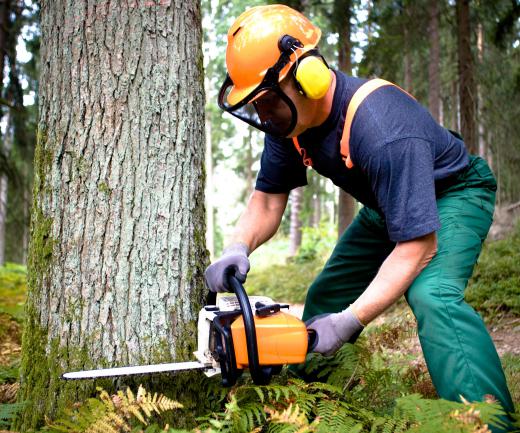A logging crew is a small but well oiled team of people who must work together to log an are effectively. There are a number of different positions on a logging crew, all of which are important, and each requires position-specific training. Even with training, logging is still an extremely dangerous occupation, with an average of almost 100 deaths per 100,000 loggers in the United States. The profession is matched only by pilots in level of danger in the United States, with fishermen taking a close third.
A logging operation of any size requires several steps before the logging crew even moves in. First, a forester assesses the site, determining how many board feet of timber can be harvested and marking specific trees for harvest. A Timber Harvest Plan (THP) must also be filed in many regions of the world, indicating intent to log and specifying which procedures will be used to protect the environment during the logging process. Once a THP has been approved, a logging crew can get to work.

Fellers or fallers are probably the most well known loggers, and their position is perhaps the most glamorous. Fellers are responsible for selecting specific trees and safely felling them in a way which maximizes harvestable timber. After a feller is finished, the bucker moves in, trimming the tree and sawing it into evenly measured logs so that the timber can be transported off site.

Once logs have been prepared, a choker or choke setter attaches chains to the logs so that they can be hauled with skidders and other heavy logging equipment. Being a choke setter is extremely dangerous, as it is easy to be severely injured, especially when logging in steep conditions. Once logs are transported to a base camp, rigging slingers detach the equipment attached by the choke setter, and sorters, markers, and movers break the logs up into various types for loading onto trucks. Extraneous material is handled by a shredder, or stacked for burning later.
Many timber companies keep log graders, also called scalers, on the site of major operations to grade trees as they are harvested and loaded on logging trucks. Log graders inspect the logs for quality and determine how the logs can best be split up into usable timber. They also keep a running database of information about all of the trees on site, showing which trees were harvested where and what kind of yields these trees ultimately had.
Finally, equipment operators on a logging crew handle all of the heavy equipment, from tractors to logging trucks. Many logging companies use highly modernized equipment which can be extremely complicated, demanding both technical and physical skill. These positions are by no means safer than those of people on the ground, as heavy equipment can cause major injuries, especially when it is operated by tired or harried crew.
All of the operations of a logging crew require close coordination for safety and efficiency. Once a logging crew falls behind, it can be impossible to catch up without sending some of the crew home while others clear the backlog. This costs money for the timber company and it also frustrates the released crew, which can lead to dangerous decisions on the job site.
Ever since she began contributing to the site several years ago, Mary has embraced the exciting challenge of being a About Mechanics researcher and writer. Mary has a liberal arts degree from Goddard College and spends her free time reading, cooking, and exploring the great outdoors.

